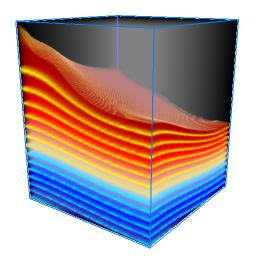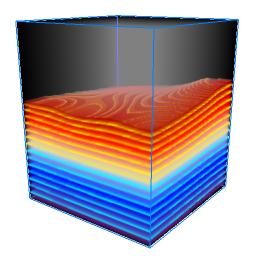

Figure 3: Vertically oscillating container: Elevation and pressure field at two instants during the simulation.
More...
|
Figure 3: Vertically oscillating container: Elevation and pressure field at two instants during the simulation. |
Space-time finite element formulations are emerging as an elegant and
mathematically well-understood way of handling fluid flow problems involving
moving boundaries and interfaces. A subset of Lagrangian-Eulerian interface
tracking techniques, the space-time methods formulate the problem using
finite element discretization in both space and time. The deformation
of the domain is accommodated by the deformation of the space-time elements
and the time-dependent nature of interpolation functions. In most
applications, the discretization of the space-time domain utilizes
slabs, which are analogous to time steps in a standard semi-discrete approach,
but that does not have to be the case. The continuity of the solution in time
is enforced weakly at slab interfaces. Within the slab, interpolation function
typically used are either constant or linear in time. The mesh in the slab
interior can be unstructured, allowing for varying time resolution in
different parts of the domain. As with any interface
tracking technique, the implementation of the interface effects, such as
surface tension, is relatively straightforward.
An example application of the space-time methodology is the simulation of
sloshing in a water-filled rectangular container, which is subjected
to vertical vibrations. The horizontal cross-section of the container
is close to square, leading to the onset of chaotic wave mode competition,
analyzed both theoretically and experimentally.
These results are reproduced here using a long-term time
dependent simulation, employing 6,000 hexahedral space-time elements.
Figure 3 shows, at three instants during the computation, the position of the
free surface and color-coded pressure distribution in the container. More... |